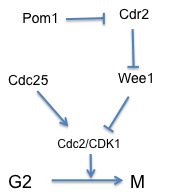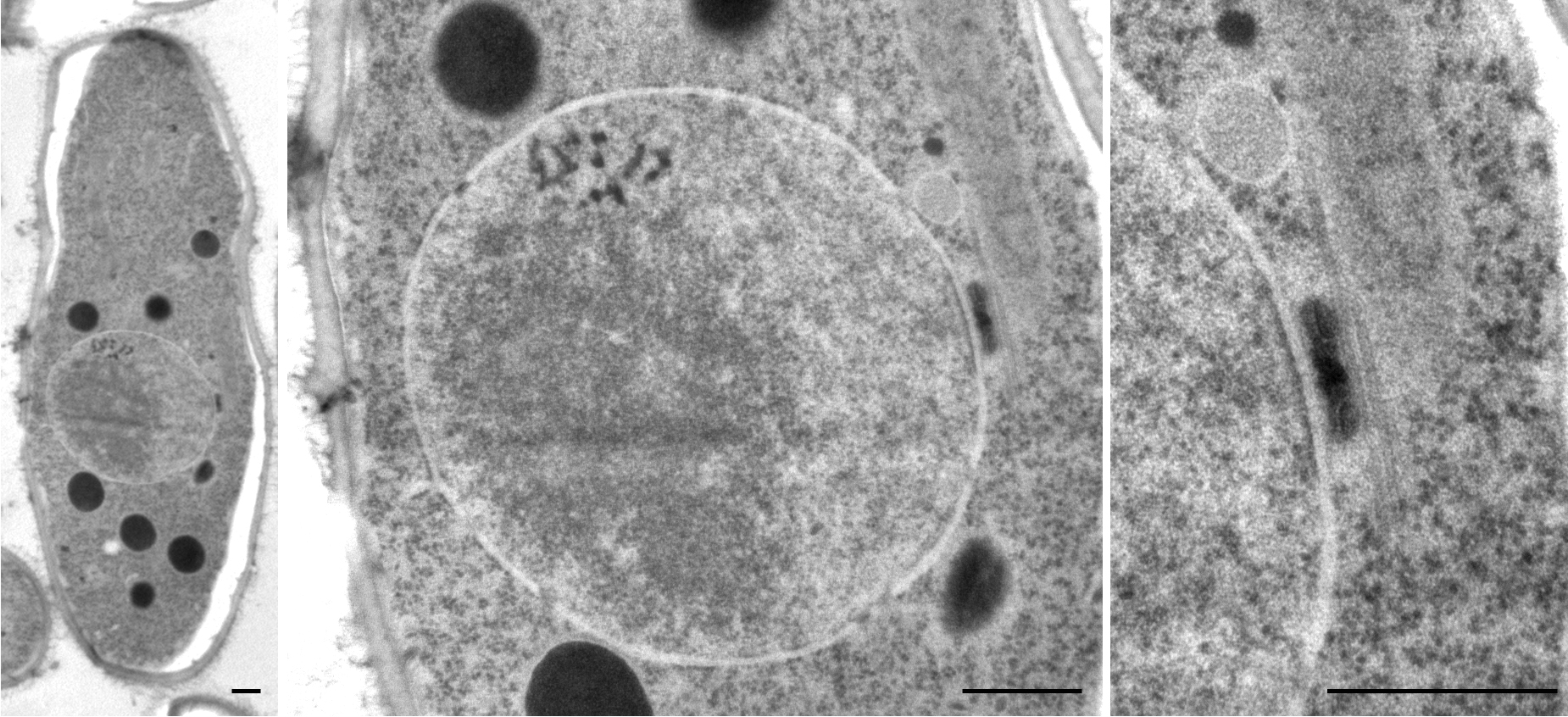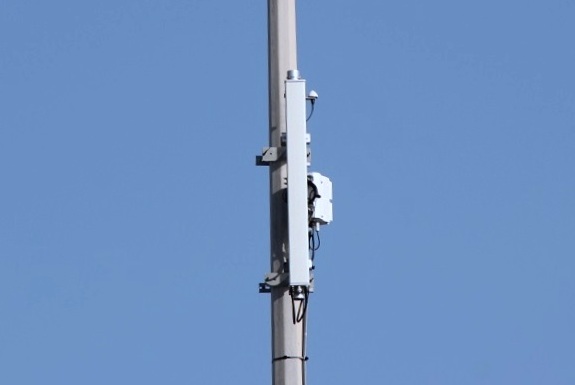|
Cdr2 (S. Pombe)
Cdr2 is a serine/threonine protein kinase mitotic regulator in the fission yeast S. pombe. It is encoded by the P87050 2247 bp ORF on the cosmid 57A10. The protein is 775 amino acids in length. Cdr2 is a member of the GIN4 family of kinases, which prevent progression of mitosis if there is a problem with septin. The N-terminus contains a sequence characteristic of serine/threonine protein kinase activity. The C-terminus, while non-catalytic, is necessary for proper localization of Cdr2 during interphase. Cdr2 null constructs behave similarly to wild-type constructs; the only difference being a slight delay into mitosis and consequently, cells are slightly larger than in wild-type constructs. Therefore, Cdr2 is non-essential. Cdr2 regulates mitotic entry through direct inhibition of Wee1, which is then unable to continue to Cdk1 and subsequently start mitosis. Cell localization During interphase (G1, S, G2), Cdr2 is localized in a wide medial band that is centered on the nucleu ... [...More Info...] [...Related Items...] OR: [Wikipedia] [Google] [Baidu] |
Schizosaccharomyces Pombe
''Schizosaccharomyces pombe'', also called "fission yeast", is a species of yeast used in traditional brewing and as a model organism in molecular and cell biology. It is a unicellular eukaryote, whose cells are rod-shaped. Cells typically measure 3 to 4 micrometres in diameter and 7 to 14 micrometres in length. Its genome, which is approximately 14.1 million base pairs, is estimated to contain 4,970 protein-coding genes and at least 450 non-coding RNAs. These cells maintain their shape by growing exclusively through the cell tips and divide by medial fission to produce two daughter cells of equal size, which makes them a powerful tool in cell cycle research. Fission yeast was isolated in 1893 by Paul Lindner from East African millet beer. The species name ''pombe'' is the Swahili word for beer. It was first developed as an experimental model in the 1950s: by Urs Leupold for studying genetics, and by Murdoch Mitchison for studying the cell cycle. Paul Nurse, a fission yeast r ... [...More Info...] [...Related Items...] OR: [Wikipedia] [Google] [Baidu] |
Wee1
Wee1 is a nuclear kinase belonging to the Ser/Thr family of protein kinases in the fission yeast ''Schizosaccharomyces pombe'' (''S. pombe'')Wee1has a molecular mass of 96 kDa and is a key regulator of cell cycle progression. It influences cell size by inhibiting the entry into mitosis, through inhibiting Cdk1. Wee1 has homologues in many other organisms, including mammals. Introduction The regulation of cell size is critical to ensure functionality of a cell. Besides environmental factors such as nutrients, growth factors and functional load, cell size is also controlled by a cellular cell size checkpoint. Wee1 is a component of this checkpoint. It is a kinase determining the timepoint of entry into mitosis, thus influencing the size of the daughter cells. Loss of Wee1 function will produce smaller than normal daughter cell, because cell division occurs prematurely. Its name is derived from the Scottish dialect word wee, meaning small - its discoverer Paul Nurse w ... [...More Info...] [...Related Items...] OR: [Wikipedia] [Google] [Baidu] |
Cdr2 Pathway
CDR may refer to: Technology * Carbon dioxide removal, ways to remove carbon dioxide from the atmosphere * Call detail record, a record of a (billing) event produced by a telecommunication network element * Charging data record, a record of a (billing) event produced by a data network element in 3GPP networks * China Digital Radio, a Chinese standard for digital radio broadcasting; competitor to DAB, HD Radio, DRM+ * Climate Data Record, a time series of measurements of sufficient length, consistency, and continuity to determine climate variability and change * Committed data rate, in telecommunications, related to the committed information rate * Crash Data Retrieval, a tool for imaging or downloading data from an Event data recorder Computing * CD-R, a recordable compact disc format * Character Detection & Recognition, the detection and recognition of images with typed characters. * CAR and CDR, in the programming language Lisp * CDR coding, in the programming language Lisp ... [...More Info...] [...Related Items...] OR: [Wikipedia] [Google] [Baidu] |
Pom1
Pom1 is a polarity protein kinase in fission yeast, ''Schizosaccharomyces pombe'' (''S. pombe''), that localizes to cell ends and regulates cell division. As the cell lengthens, the level of Pom1 in the middle declines, which triggers mitosis.Bahler, J., and Pringle, J.R. “Pom1p, a fission yeast protein kinase that provides positional information for both polarized growth and cytokinesis.” Genes and Development 12, 1356-1370 (1998). The genebr>''pom1''codes for a protein 1087 amino acids long with the protein kinase domain likely located at the carboxyl terminus. Pom1 regulates a signaling pathway that includes Cdk1 and ultimately regulates mitotic entry.Moseley, J.B., Mayeux, A., Paoletti, A. and Nurse, P. “A spatial gradient coordinates cell size and mitotic entry in fission yeast.” Nature 459, 857-861 (2009). Cells with mutant pom1 form a septa and growth zone, but show a host of abnormalities including misplaced or misoriented septa, bi-polar growth replaced with r ... [...More Info...] [...Related Items...] OR: [Wikipedia] [Google] [Baidu] |
Small Cell
Small cells are low-powered cellular radio access nodes that operate in licensed and unlicensed spectrum that have a range of 10 meters to a few kilometers. In other words, they are base stations with low power consumption and cheap cost that are operated in a licensed spectrum. They can provide high data rates by being deployed densely to achieve high spatial spectrum efficiency. Recent FCC orders have provided size and elevation guidelines to help more clearly define small cell equipment. They are "small" compared to a mobile macrocell, partly because they have a shorter range and partly because they typically handle fewer concurrent calls or sessions. As wireless carriers seek to 'densify' existing wireless networks to provide for the data capacity demands of "5G", small cells are currently viewed as a solution to allow re-using the same frequencies, and as an important method of increasing cellular network capacity, quality, and resilience with a growing focus using LTE ... [...More Info...] [...Related Items...] OR: [Wikipedia] [Google] [Baidu] |



